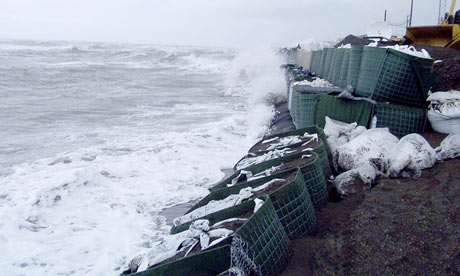'Climigration' requires a new and unique institutional response based in human rights doctrine
- guardian.co.uk, Friday 17 April 2009 09.30 BST

Waves pounding against the sandbagged seawall in Kivalina, Alaska. In 2006, a recently completed $2.5m sea barrier was partly destroyed. The community was evacuated in 2007. Photograph: Mary Sage/AP
In Alaska, climate change is creating an unforeseen humanitarian crisis. Arctic sea ice – which had protected communities from coastal erosion and flooding – is rapidly disappearing and signalling a radical transformation of this northern ecosystem. Scientific observations during the summer of 2007 documented a new record low.
In 2006, the US government completed a $2.5m (£1.7m) seawall to protect the native village of Kivalina, located on an island in the Chukchi Sea. But on the day of the dedication ceremony, a storm surge partly destroyed the newly constructed sea barrier. One year later, the community was evacuated to protect inhabitants from a severe storm.
The situation looks set to get worse. Winter temperatures along the northern Alaskan coast have increased an average of 3.5C (38.3F)since 1975. These warming temperatures are causing the arctic seas to freeze later in autumn and the permafrost – usually permanently frozen subsoil – to thaw. Along the northwestern Alaskan coast, permafrost is the glue that keeps the land intact and habitable.
Approximately 200 indigenous villages that have inhabited the arctic for millennia are located along Alaska's coasts and rivers. Dozens of these communities are now endangered because of accelerating erosion and flooding. Five indigenous communities, located along the Bering and Chukchi Seas, have concluded that relocation is the only durable solution to the climatic events that are threatening their lives.
Government agencies now realise that erosion and flooding control can no longer protect these coastal communities. In 2006, a US government report found that relocation of three communities is required because a catastrophic climatic event could submerge them within 10-15 years. Despite these dire predictions, no community has yet been relocated because of the governance issues that must be addressed to facilitate relocation. The report recognised that no government agency has the authority to relocate communities, no governmental organisation exists that can address the strategic planning needs of relocation, and no funding is specifically designated for relocation.
Since 2006, government officials have organised numerous meetings to address the policy and practical challenges of relocation. One village, Newtok, is in the relocation process. The Newtok Planning Group is the only interdisciplinary governmental workgroup in Alaska focused on relocation. The Newtok Traditional Council is leading the effort.
Next week in Alaska, the Inuit Circumpolar Conference will host a gathering of indigenous peoples from all over the world. The goal is to develop recommendations for the UN Convention on Climate Change meeting in December 2009. One of the topics will be the creation of a human rights regime to protect those forced to relocate because of climate change. "Climigration" is the word that best describes this type of population displacement. Climigration requires a new and unique institutional response based in human rights doctrine. Communities, rather than individuals, will be forced to migrate. Permanent relocation will be mandated because there will be no ability to return home because home will be under water or sinking in thawing permafrost.
Catastrophic random environmental events, such as hurricanes, do not cause climigration. However, these random environmental events, if on-going, may alter ecosystems permanently, cause extensive damage to public infrastructure, repeatedly place people in danger and require communities to relocate. Determining which communities are most likely to encounter displacement will require a complex assessment of a community's ecosystem vulnerability to climate change, as well as the vulnerability of its social, economic and political structures. Permanent relocation must only occur when there are no other durable solutions.
International human rights principles need to be specifically created for climigration to ensure that the social, economic and cultural human rights of individuals and the communities forced to migrate are protected. These principles will ensure that the affected community is a key leader and decision-maker in the relocation process. The principles will also affirm that families and tribes remain together. For indigenous communities, tribal relationships are essential to cultural identity.
The Intergovernmental Panel on Climate Change (IPCC) predicts that 150 million people may be displaced by climate change by 2050. The United Nations University has developed an international research agenda on climate change and forced migration. The IPCC needs to convene an expert working group to fully develop the human rights framework that will guide nation-states in addressing climigration. The time to act is now.
Robin Bronen is a human rights attorney and a National Science Foundation fellow. She lives in Anchorage, Alaska.

No comments:
Post a Comment